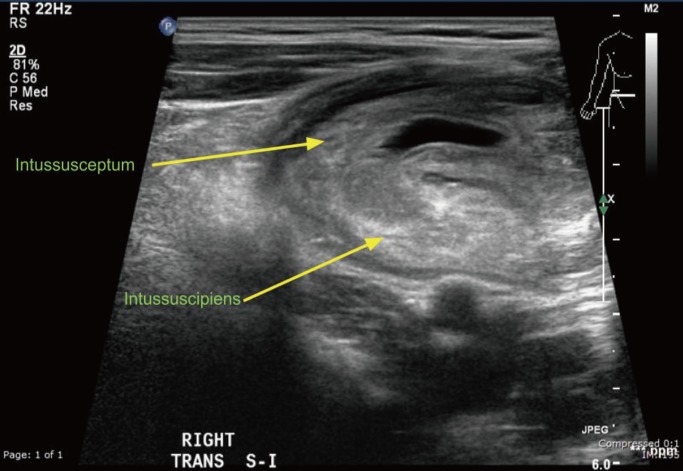INTRODUCTION
Intussusception is a relatively rare condition in the adult population, affecting 2–3 per 1,000,000 population per annum [1]. In adults, intussusception is more commonly due to a malignant process. However, 8%–20% of cases of adult intussusception [2] are thought to be idiopathic. In the pediatric population, infection has been shown to be a cause of intussusception [3]; however, evidence is lacking to support this in the adult population. We present a rare case of ileo-colonic intussusception secondary to salmonella enteritis in an adult female patient. A literature search reveals just three previously documented cases of adult intussusception secondary to salmonella enteritis; all were treated surgically, and histology revealed no malignancies. We suggest that salmonella and other infective causes may account for the proportion of cases of adult intussusception thought to be idiopathic and should be considered and tested for once malignant causes have been excluded.
CASE REPORT
A 24-year-old previously-well female presented to our health service with a 3-day history of right iliac fossa pain, vomiting, and diarrhea with four to 5 episodes of watery stools per day. On admission, pathology investigations highlighted an elevated neutrophil count of 8.6 × 109/L and a C-reactive protein of 66 mg/L. Sonographic findings were consistent with an ileocolic intussusception with prominent right iliac fossa lymph nodes as the potential lead point (Fig. 1). The diagnosis was confirmed on an abdominal computed tomography (CT) scan, which revealed an ileocolic intussusception with telescoping of the terminal ileum to the hepatic flexure (Fig. 2), as well as regional lymphadenopathy. She proceeded to undergo a laparoscopic right hemicolectomy, which confirmed the presence of intussusception and marked lymphadenopathy throughout the resected mesocolon. Macroscopic pathological examination revealed a 45 × 20 × 15-mm polypoid mass originating in the caecum. This acted as the lead-point for the intussusception. Histological examination of the polypoid mass revealed extensive surface ulceration with marked oedema of the lamina propria and extensive infiltration with acute inflammatory cells. No evidence of any ectopic epithelium or any granuloma or atypia was found. Forty-five lymph nodes were identified in the specimen, none of which showed abnormality on histological examination. Distant from the sites of intussusceptions, 2 polypoid lesions were identified in the small bowel, which histology confirmed to be Peyer's patches. These histological findings are mostly in keeping with an acute inflammatory cause, such as infection, and are in keeping with histological findings in previous cases of intussusception secondary to salmonella enteritis [4]. In our case, diagnosis was confirmed when the stool culture and polymerase chain reaction testing returned a positive result for the Salmonella specie.
DISCUSSION
Intussusception refers to the telescoping of one part of the intestine into itself. Most commonly, it occurs in the ileo-colic portion of the intestine, but may less commonly affect other regions. It is the most common cause of intestinal obstruction in the 6- to 36-month age group [5]. Population daum is from Switzerland describe incidence rates of 38, 31, and 26 cases per 100,000 population in the first, second, and third years of life, respectively [6]. In children, approximately 75% of cases of intussusception are idiopathic and do not involve a known disease trigger or pathological lead point [7]; however, a retrospective cohort study showed that the relative risk for intussusception following any bacterial enteritis was 40.6 [3]. The majority cases of pediatric ileo-colic intussusception can be safely managed non-operatively with either hydrostatic or pneumatic pressure by using an enema under sonographic or fluoroscopic guidance [7].
In contrast, adult intussusception is a relatively rare condition. Adult intussusception represents only 5% of intussusceptions and is the cause for only 1% of bowel obstructions in adults [8]. It has an estimated incidence rate of just 2–3 cases per 1,000,000 population per annum [1]. In contrast to cases of intussusception in children, where 90% of cases are idiopathic, just 8%–20% of cases of adult intussusception are thought to be idiopathic [2]. Of the approximately 90% of adult cases of intussusception that are associated with a pathological process that serves as a lead point, 65% are thought to be associated with malignancy [2]. Given this, surgical management is generally required in adults.
A comprehensive Medline and Google Scholar literature search with search parameters ‘salmonella’ and ‘intussusception’ revealed just 3 previously documented cases of adult intussusception secondary to salmonella infection in adults. Goodall [9], Matsushita et al. [4], and Beltrán et al. [10] described three independent cases of ileo-colic intussusception in adults that required surgical management. In those 3 cases, histological examination revealed a benign pathology with the oedematous mucosa containing inflammatory exudate. Stool tests from those cases were indicative of salmonella infection, with no other cause identified.
The incidence of adult intussusception is extremely rare [1], with the majority of cases being secondary to a malignant lead point. Nevertheless, the fact that childhood causes can still be present in adulthood, as evidenced in the three published cases, with our case being the fourth, is interesting. We hypothesize that salmonella, along with other infectious causes, may form part of the 8%–20% of cases of adult intussusception that are thought to be idiopathic. We suggest testing for infectious causes of intussusception in adult patients after more common causes, such as malignancy, have been excluded.









